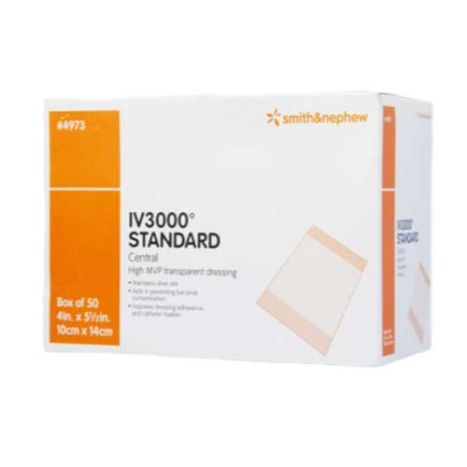IV3000 Standard Transparent Film Central/Jugular IV Dressings come with orange handles for easy tape fixation. 4973 Dressings are moisture responsive cannula fixation dressings manufactured by Smith & Nephew. The IV3000 Standard dressing is indicated for peripheral and central venous catheter fixation. These transparent dressings are moisture responsive and specifically designed to meet the needs of catheter fixation. The IV3000 Central or Jugular IV Dressing helps keep the catheter site dry by trasmitting moisture away from the wound.Orange adhesive handles provide quick and easy application.
Smith & Nephew also manufactures other OpSite Dressings, including Opsite Flexigrid, Opsite Flexifix, Opsite Post-Op, Opsite Post-Op Visible and other IV3000 Dressings.
IV3000 Transparent Film IV Dressing Features & Benefits
- Standard IV application for central or jugular.
- Film acts as a barrier to bacteria including MSRA.
- Offers convenient visual inspection.
- Offers greater patient comfort.
- Reduces dressing changes.
- Provides excellent catheter stabilization.
- Easy application and removal.
- Waterproof barrier.
- Minimizes unscheduled dressing changes.
- Moisture responsive cannula fixation dressing.
- Grid pattern adhesive.
- Transparent and conformable.
- Provides physical separation between the catheter site and external environments to assist in preventing contamination of the catheter site.
- Creates an environment for managing moisture at the catheter site through increased moisture vapor transmission rates.
- May help reduce risk of infection by preventing moisture accumulation.
IV3000 1-Hand Transparent Film Central or Jugular IV Dressings Specifications
- IV3000 Standard Transparent Film Central IV Dressing Product Number: 4973.
- Width: 4 Inch.
- Length: 5-1/2 Inch.
- Use: Moisture responsive cannula fixation dressing.
- Application: Central IV Catheter Dressing.
- Color: Transparent.
- Manufacturer: Smith & Nephew.
- Brand: Opsite.
- Sub brand: IV3000 Standard.
- HCPCS Code: A6258.
- UNSPSC Code: 42311505.
IV3000 Dressings Additional Information
- Pratt RJ et al. epic2: National Evidence-based Guidelines for Preventing Healthcare-Associated Infections in NHS Hospitals in England. J Hosp Inf 2007; 65S: S1-S64.
- Treston-Aurand, J et al. Impact of Dressing Materials on Central Venous Catheter Infection Rates. J Intraven Nurs 1997; 20: 201-6.
- Campbell H, Carrington M. Peripheral IV cannula dressings: advantages and disadvantages. Br J Nurs. 1999; 8: 1420-2, 1424-7.
- Tripepi-Bova KA, Woods KD, Loach MC. A comparison of transparent polyurethane and dry gauze dressings for peripheral i.v. catheter sites: rates of phlebitis, infiltration, and dislodgment by patients. Am J Crit Care. 1997; 6: 377-81.
- Besley, M. OPSITE IV3000: Potential for improved quality of life for haemodialysis patients with permanent central venous catheters in Maki, D G ed. International Congress and Symposium Series No 179 Improving Catheter Site Care, Royal Society of Medical Services Ltd, London. New York, 1991 57-59(in-vitro).
- Richardson, MC (1991) An in-vivo assessment of microbial proliferation under transparent film dressings. In Maki, DG, Ed., International Congress and symposium Series No 179, 'Improving catheter site care'. Royal Society of Medicine Series, London, New York, 29-33.
- Wheeler S et al. A prospective, randomised, three-way clinical comparison of a novel, highly permeable, polyurethane dressing with 206 Swan-Ganz pulmonary artery catheters: OPSITE IV3000 vs. Tegaderm vs. gauze and tape. II. Nursing issues: effectiveness and tolerance as catheter dressings. In: Maki, DG, ed, International Congress and Symposia Series No. 179, 'Improving Catheter Site Care', Royal Society of Medicine Series, London, New York, 1991, 67-72.(in-vitro).


Login and Registration Form